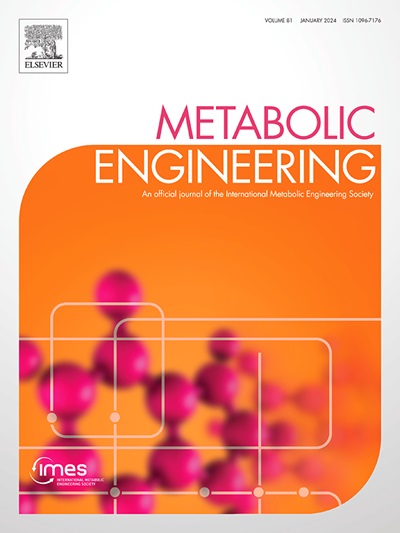The oleaginous yeast Rhodosporidium toruloides engineered for biomass hydrolysate-derived (E)-α-bisabolene production
IF 6.8
1区 生物学
Q1 BIOTECHNOLOGY & APPLIED MICROBIOLOGY
引用次数: 0
Abstract
The oleaginous yeast Rhodosporidium toruloides has been exploited for many bioproducts, including several terpenes, owing to its oleaginous nature and biomass inhibitor tolerance. Here, we built upon previous (E)-α-bisabolene work by iteratively stacking the complete mevalonate pathway from Saccharomyces cerevisiae onto a multicopy bisabolene synthase parent strain. Metabolomics and proteomics verified heterologous pathway expression and identified metabolic bottlenecks at three intermediate steps, with candidate feedback-resistant mevalonate kinases screening improving titers 15%. Subtle differences in codon optimization, and preliminary attenuation of competing flux toward lipids resulted in 6-fold, 7-fold higher titers relative to controls, respectively. Media optimization led to modest improvements, with zinc identified as the most promising at 10% titer improvement. Ultimately, high-performance strains were cultivated with corn-stover biomass hydrolysate in microtiter plates at 300 g/L total sugar, achieving 20.8 g/L bisabolene, the highest reported titer in the literature. A 2 L glucose minimal medium bioreactor achieved 19.3 g/L bisabolene and a literature-high productivity of 0.11 g/L/h.
求助全文
约1分钟内获得全文
求助全文
来源期刊

Metabolic engineering
工程技术-生物工程与应用微生物
CiteScore
15.60
自引率
6.00%
发文量
140
审稿时长
44 days
期刊介绍:
Metabolic Engineering (MBE) is a journal that focuses on publishing original research papers on the directed modulation of metabolic pathways for metabolite overproduction or the enhancement of cellular properties. It welcomes papers that describe the engineering of native pathways and the synthesis of heterologous pathways to convert microorganisms into microbial cell factories. The journal covers experimental, computational, and modeling approaches for understanding metabolic pathways and manipulating them through genetic, media, or environmental means. Effective exploration of metabolic pathways necessitates the use of molecular biology and biochemistry methods, as well as engineering techniques for modeling and data analysis. MBE serves as a platform for interdisciplinary research in fields such as biochemistry, molecular biology, applied microbiology, cellular physiology, cellular nutrition in health and disease, and biochemical engineering. The journal publishes various types of papers, including original research papers and review papers. It is indexed and abstracted in databases such as Scopus, Embase, EMBiology, Current Contents - Life Sciences and Clinical Medicine, Science Citation Index, PubMed/Medline, CAS and Biotechnology Citation Index.
 求助内容:
求助内容: 应助结果提醒方式:
应助结果提醒方式:


